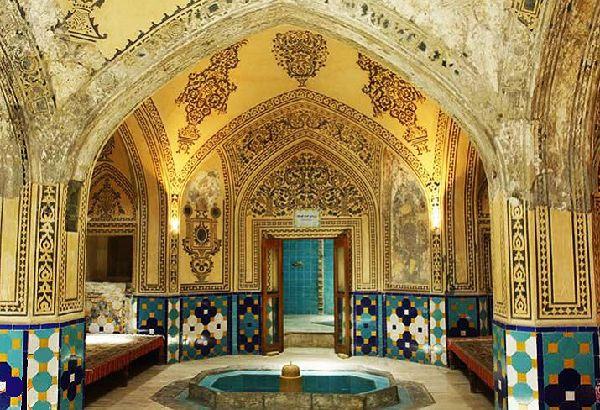Personal hygiene is one of the most important principles in both Zoroastrianism and Islam, and the public bathhouses in old Iranian cities were a place for cleaning, socializing, relaxing and even councils. Historical Iranian bathhouses have 4 different sections with different temperature that leads the people from the cold room to the hot water room gradually and vice versa.
The main sections of an Iranian bathhouse
Sardkhaneh / Bineh / Sar Bineh (the cold room):
It is an octagonal room with a dome roof, which is cold and dry and is furnished with benches on which people could sit and change to get ready for bathing.
Mian Dar (the middle room):
A cold but wet corridor which connects the Bineh to Garmkhaneh and doesn’t let the heat and energy inside the bathhouse to be wasted.
Garmkhaneh (warm room):
This room with warm temperature and a wet atmosphere is where people spend the most time to do the bathing.
Khazineh:
This is the most fun part, where cold or hot water tanks are located and people can get relaxed after taking a long shower. Khazineh is similar to modern Jacuzzi pools.
Bathhouses of Iran are also known for having very eye-catching ornaments, and below are some of the most picturesque Iranian bathhouses that everyone should visit when they travel to Iran:
1- Ganjali Khan Bathhouse – Kerman
Constructed in 1631 during the Safavid Dynasty, the Ganjali Khan Bathhouse (Ganjali Khan Hammam) is located in a historical bazaar with the same name and is one of the most vital attractions of Kerman. The entrance is decorated with very unique paintings and the dressing room is divided into 6 parts and each part is devoted to a social class, including Seyeds, merchants, chiefs, etc. Ganjali Khan Bathhouse of Kerman was converted to an anthropological museum in 1971.
 |
| Ganjali Khan Bathhouse - Kerman,Iran |
2- Sultan Amir Ahmad Bathhouse – Kashan
This bathhouse was first constructed in Kashan during the 16th century (Safavid Era), and then it was renovated during the Qajar Era after it ruined by an earthquake. Sultan Amir Ahmad Bathhouse, which is also named Qasemi Bathhouse, consists of two main parts, including the Sarbineh (dressing room), which is an octagonal hall, and the Garmkhaneh (hot bathing hall) which is divided into smaller bathing rooms. The interior is decorated with turquoise and gold tile works, brickwork and plasterwork, while the roof of the bathhouse is made of multiple domes with glasses that provide light into the bathhouse.
 |
| Sultan Amir bathhouse- kashan,Iran |
3- Vakil Bathhouse – Shiraz
Built under the command of Karimkhan, the generous king of Iran during the Zandiyeh Dynasty, Vakil Bathhouse is one of the most stunning ones in Iran. This bath is located at the heart of Darb-e Shazdeh old district and beside the Vakil Bazar. The paintings and plasterworks on the ceiling over the octagonal pond, show mythical and religious Iranian stories and amaze visitors. The realistic statues in the Vakil Bathhouse, which is today used as an anthropology museum, show how locals spent time and washed in this bath 150 years ago.
 |
| Vakil Bathhouse- Shiraz, Iran |
4- Ali Qoli Agha Bathhouse – Isfahan
Although this construction is not as famous as other attractions of Isfahan, Ali Gholi Agha Bathhouse is a must see for architecture lovers. This bathhouse was built during the Safavid Dynasty by the order of Mr. Ali Gholi Agha, one of the courtiers of Safavid kings. The building of this royal bathhouse consists of a small bath, a big bath, and a space assigned to the big pond, all with separate dressing rooms and washing rooms. The walls are beautifully decorated with delicate tilework, which are similar to the tilework in the Jame Imam Mosque of Isfahan and lime paintings and plasters. The ceiling of Ali Gholi Agha Bathhouse is designed with a geometric technique named Rasmi Bandi and skylights lets daylight shine into the building and create a pleasant atmosphere.
|
|
| Ali Qoli Agha Bathhouse - Isfahan,Iran |
5- Fin Bathhouse – Kashan
Located inside the Fin Garden, which is one of the scenic Persian Gardens inscribed as UNESCO world heritage sites, Fin bathhouse is important for being the place at which AmirKabir, the chief minister of Qajar Kingdom, was executed. Fin Garden is divided into two parts, including the small bath and the large bath. The construction of the small bath dates back to the Safavid Dynasty when the garden was built. Since this bath was used by the servants and the staff, it doesn’t show any significant ornaments and architectural design and it is only known for the historical incident of Amir Kabir’s execution taking place at this spot. The large bathhouse was built inside the garden during the Qajar Dynasty by the order of Fath Ali Shah, when the small bathhouse was renovated, too. Since the large bathhouse was used by the governors and chiefs, it has eye-catching decorations like lime plasters and marble columns.
 |
| Fin Bathhouse - Kashan,Iran |
6- Khan Bathhouse – Yazd
This bathhouse is located at the heart of Yazd old city, which was built about 200 years ago (during the Qajar Dynasty) by the command of Muhammad Taghi Khan, the former commander of Yazd. In Persian “Khan” means commander and the reason why they named this bathhouse “Khan”, was that it was mainly used by the chiefs and people with high social class. This construction is recognizable by its simple yet eye-catching ornaments, including brickworks and turquoise tile works.
 |
| Khan Bathhouse - Yazd,Iran |



